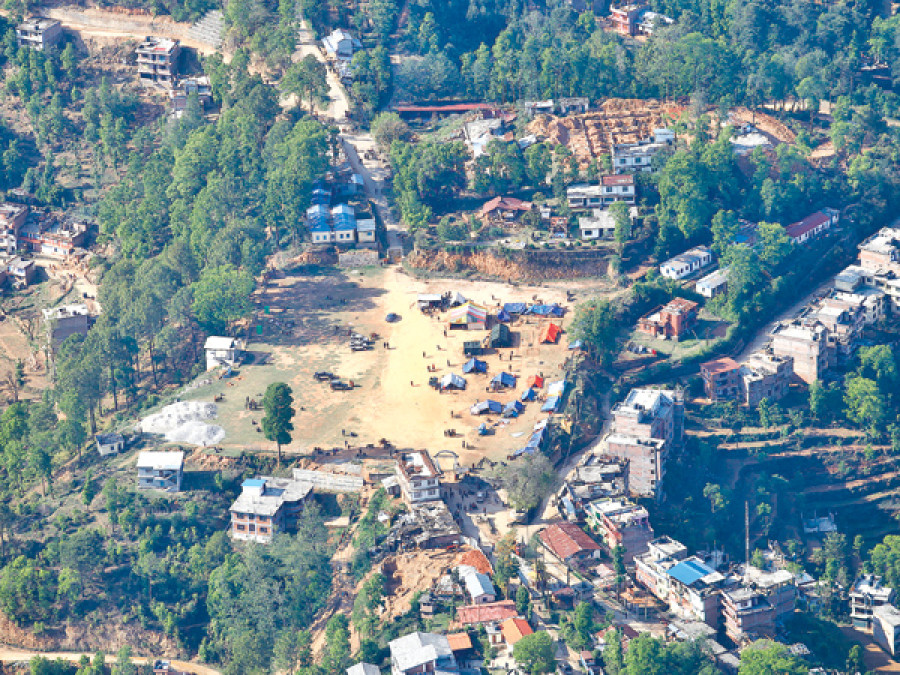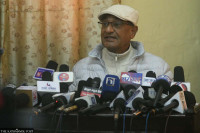National
None of battered Sindhu rebuilt in a year
When the devastating earthquakes nearly wiped out the whole of Sindhupalchok last year, no one there had probably thought that they would still be living in makeshift shelters when another rainy season adds to their misery.
Rishiram Paudyal
When the devastating earthquakes nearly wiped out the whole of Sindhupalchok last year, no one there had probably thought that they would still be living in makeshift shelters when another rainy season adds to their misery.
But that is what exactly has happened. In spite of the government getting billions of dollars in international aid pledges, no money has trickled down to the site of devastation to help people rebuild their homes. As a result, many children have dropped out of school and businesses in the district have been ruined, not to mention lost hope and livelihoods.
In Tatopani on the Nepal-China border, the Family Guest House run in a five-storey building has been locked for a year. Kami Sherpa had invested Rs30 million to open the hotel at the major trade and transit point between the two countries.
However, his business was affected after the devastating earthquake of April 25, 2015. “I have no hope that business activity in Tatopani will pick up again. I have lost everything,” said Sherpa.
There were 65 hotels run in the border town alone. All of them—big and small—near the border have been shut. Many entrepreneurs have no money to pay interests to banks. “We had never imagined this kind of disaster in our life,” said Bishnu Bahadur Shrestha, owner of the Small Heaven hotel .
Many people living in Listi, Marmin, Gati, Barhabise, Pangtang, Hagam, Jalbire, Maneshora, Ramche, Ghumthang and Phulpingkatti depended on Tatopani for their daily income. Container driver Bishnu Pradhan of Ghumthang, who earned Rs15,000 each month, is now jobless.
“I have not thought of what I will do next. My family has not been able to forget the disaster a year after. We have no enough farmland,” said Pradhan, informing about his inability to provide for the family’s basic needs.
In the past, around 1,500 people were directly engaged in income generation activities at Tatopani.
Many of the quake-affected households have no alternative but to shift back to their original place. The four-member family of 66-year-old Nima Sherpa is preparing to leave Tatopani. Hundreds of container drivers remain jobless in Ghumthang. Many of them plan to go for jobs abroad.
As Chinese authorities discuss whether to rebuild their destroyed Khasa town, Nepali traders have appealed for resuming cross-border trade.
The supply of Chinese goods via Tatopani remains halted for a year. Most of the imports from China used to come via this route. Chairman of the Sindhupalchok Chamber of Commerce and Industry Kamal Kumar Shrestha said the country has suffered a huge loss as exports to and imports from China from here have come to a standstill.
The stretch of Araniko Highway from Jaletar to Sirsire, Borderland, Sakhuwa, Nayapul, Chaku, Daklang, Hindi, Jhirpu, Larcha, Dashkilo, Parking, Kodari and Liping Bazaar near the Miteri bridge face high risk of landslides after the devastating quake.
People living in Tatopani and its vicinity have not returned to their homes. The dry port being constructed by China in Larcha remains incomplete. Recurring dry landslides have obstructed construction works.
The tourism industry faced a huge setback after the disaster. There are no tourists in resorts and hotels. As the Chinese authorities deny access via the border point to Mansarovar in Tibet, hotel and restaurant operators have suffered heavy losses. Padam Magar of Himalayan Eco Resort said around 25,000 Indian tourists used to visit Kailash and Mansarobar via Tatopani.
Locals have pressed the government for initiatives to reopen the border. But Chinese authorities have proposed demolishing the damaged bridge to reconstruct a new one. According to sources at Nepal’s Foreign Ministry, the Chinese government is unwilling to reopen the border immediately.
Hundreds of students in Tatopani have quit school. The headmaster of Kodari Higher Secondary School said the people living in border areas have returned to their villages. “We don’t know where the children have gone,” he said.
Two private schools there were shut after the quake. Headmaster of Tatopani Lower Secondary School Goma Koirala said they have been running classes in risky conditions. Around 75 percent people have left Tatopani after the earthquakes. Though some of them had returned after a few days of disaster, they have been planning to shift to safer locations in view of the upcoming rainy season.
At least 3, 575 people are known to have died in Sindhupalchok. The District Disaster Management Committee said 95 percent houses were affected. The National Reconstruction Authority (NRA) has yet to provide reconstruction aid to the displaced families in the district. Some survivors have started rebuilding houses. Dal Bahadur Bharati of Kunchok-3 said he constructed a mud and stone house.
“My house is not quake-resistant as the government did not help,” said Bharati, adding that his family could not stay in flimsy shelters anymore. Bhakta Bahadur Majhi of Shikharpur-4 is also rebuilding his house on his own.
There are 68 VDCs and two municipalities in the district. Many people of Barhabise, Melamchi, Lamosanghu, Balephi, Sipaghat, Kothe and Sukute are still living in huts. Local Development Officer Krishna Bahadur Shahi said the reconstruction authority will establish its unit in Chautara, the district headquarters.




 7.12°C Kathmandu
7.12°C Kathmandu













%20(1).jpg&w=300&height=200)

